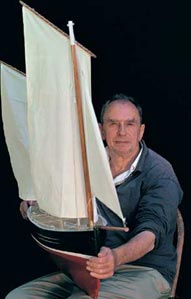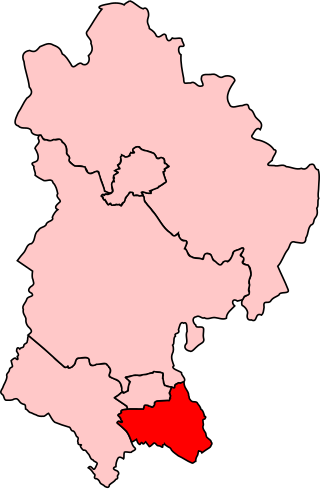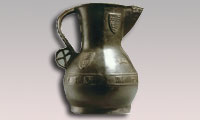
Luton is a town and unitary authority with borough status, in Bedfordshire, England. At the 2021 census, the Luton/Dunstable urban area, including the adjacent towns of Dunstable and Houghton Regis, had a population of 286,450.

Bedfordshire is a ceremonial and historic county in the East of England. It is bordered by Northamptonshire to the north, Cambridgeshire to the north-east and east, Hertfordshire to the south and south-east, and Buckinghamshire to the west. Since Bedfordshire County Council was abolished in 2009, the county has been administered by the three unitary authorities of the Borough of Bedford, Borough of Luton, and Central Bedfordshire. It is the fourteenth most densely populated county of England, with over half the population of the county living in the two largest built-up areas: Luton (258,018) and Bedford (106,940). Its highest elevation point is 243 metres (797 ft) on Dunstable Downs in the Chilterns.

Ian Hamilton Finlay, CBE was a Scottish poet, writer, artist and gardener.

Luton South is a constituency in Bedfordshire represented in the House of Commons of the UK Parliament since 2019 by Rachel Hopkins, a member of the Labour Party.

Farley Hill is a suburb of south Luton, Bedfordshire, England. The area is roughly bounded by the Dallow Downs to the north and north-east, Stockwood Park to the south, the M1 motorway to the west, and Wilsden Avenue and Bolingbroke Road to the east.

Houghton Regis is a market town and civil parish in Bedfordshire, East of England.

Wardown Park is situated on the River Lea in Luton. The park has various sporting facilities, is home to the Wardown Park Museum and contains formal gardens. The park is located between Old Bedford Road and the A6, New Bedford Road and is within walking distance of the town centre.

The Mossman Carriage Collection is a museum housing a collection of horse-drawn vehicles in Stockwood Park, Luton, Bedfordshire. It is the largest collection of such vehicles in the United Kingdom, and includes original vehicles dating from the 18th, 19th and 20th centuries.

Wardown House Museum and Gallery formerly Wardown Park Museum and, before that, the Luton Museum & Art Gallery in Luton, is housed in a large Victorian mansion in Wardown Park on the outskirts of the town centre. The museum collection focuses on the traditional crafts of Bedfordshire, notably lace-making and hat-making. There are samples of Bedfordshire lace from as early as the 17th century.

Stockwood Park is a large urban park in Luton, Bedfordshire, in the Farley Hill estate. With period formal gardens, leading crafts museums, Stockwood Park Rugby Club and extensive golfing facilities, it is about 100 hectares in area.

Luton International Carnival is a large carnival in Luton, Bedfordshire. The carnival is commissioned by Luton Borough Council and is artistically produced by UK Centre for Carnival Arts, which is based in Luton town centre.
This article is about the history of Luton, a large town located in the south of Bedfordshire, England.

Dunstable is a market town and civil parish in Bedfordshire, England, east of the Chiltern Hills, 30 miles north of London. There are several steep chalk escarpments, most noticeable when approaching Dunstable from the north. Dunstable is the fourth largest town in Bedfordshire and along with Houghton Regis forms the westernmost part of the Luton/Dunstable urban area.

A folk museum is a museum that deals with folk culture and heritage. Such museums cover local life in rural communities. A folk museum typically displays historical objects that were used as part of the people's everyday lives. Examples of such objects include clothes and tools. Many folk museums are also open-air museums and some cover rural history.

Worthington George Smith was an English cartoonist and illustrator, archaeologist, plant pathologist, and mycologist.

Luton Corporation Tramways served the town of Luton in Bedfordshire from 21 February 1908 until 16 April 1932.

High Town is an inner area of Luton immediately north of Luton railway station, and a ward of the Borough of Luton, in the ceremonial county of Bedfordshire, England.

The Wenlok jug or Wenlock jug is a rare surviving example of an English bronze jug from the 15th century, with great significance for the study of bronze working in medieval England. Only two similar jugs are known in the UK. The Wenlok jug is the smallest of the three, but bears the earliest maker's mark for the English founder - possibly a bell founder - who cast it. The other examples are the Asante Ewer, which retains its lid and is held by the British Museum having been found at Kumasi in the Gold Coast in 1896 during the Anglo-Ashanti wars, and the Robinson jug, which was found in a farmhouse in Norfolk in the 1879 and is now in the collection of the Victoria & Albert Museum. All bear inscriptions in English and were made from leaded bronze, an alloy of copper, tin and lead, cast in a two-part mould in a similar manner using bronze spacers to separate the inner and outer moulds, with similar decorative motifs.
Thomas Wyatt Bagshawe was an explorer, museum curator and folklorist.




















